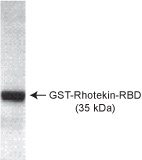Rhotekin-RBD protein (binds active Rho proteins)
Product Uses Include
- Precipitation of active Rho from cell lysates
- Inhibition of RhoA/B/C activity in vitro
- Blocking of RhoA/B/C function in vivo by microinjection
Material
The Rho binding domain (RBD) of the human Rhotekin protein has been expressed as a GST-fusion protein in E. coli. This protein binds binds specifically to GTP-bound, and not GDP-bound, RhoA, RhoB and RhoC proteins. The domain can therefore be used to specifically precipitate active, GTP-bound Rho proteins as well as to specifically block the activity of RhoA/B/C in vitro and in vivo.
The GST-Rhotekin-RBD contains residues 7-89 of Rhotekin. This region includes the sequences required for the high affinity interaction with GTP-Rho.
The protein is supplied as 500 µg of lyophilized product and the protein is also available in a bead bound format (Cat. # RT02). This product is used in our RhoA pulldown activation assay Biochem Kit™ (Cat. # BK036)
Purity
Protein purity is determined by scanning densitometry of Coomassie Blue stained protein on a 12% SDS polyacrylamide gel. GST-Rhotekin-RBD protein is >90% pure (see Figure 1).

Figure 1: GST-Rhotekin-RBD protein purity determination. A 10 µg sample of RT01 was separated by electrophoresis in a 12% SDS-PAGE system and stained with Coomassie Blue.
Biological Activity
The Rhotekin-RBD protein specifically recognizes and binds to the active, GTP-bound, form of RhoA, RhoB or RhoC protein. It has a much lower affinity for the inactive, GDP-bound, form of RhoA/B/C. Biological activity of Rhotekin-RBD protein is therefore determined by its selectivity for GTP-RhoA protein.
For product Datasheets and MSDSs please click on the PDF links below. For additional information, click on the FAQs tab above or contact our Technical Support department at tservice@cytoskeleton.com
Question 1: Can the Rhotekin-RBD protein be used to localize active small G-proteins in cells?
Answer 1: GST-tagged rhotekin-RBD (Cat. # RT01) proteins has been used to identify activated small G-proteins in fixed and permeabilized cells. Examples of this technique are reported in Berdeaux et al., 2004 (Active Rho is localized to podosomes induced by oncogenic Src and is required for their assembly and function. J. Cell Biol. 166, 317-323) and Zhao et al., 2007 (Force activates smooth muscle -actin promoter activity through the Rho signaling pathway. J. Cell Sci. 120, 1801-1809). Cytoskeleton has not verified this technique as a viable and accurate means of localizing activated small G-proteins and because it is not a widely utilized technique, we cannot confirm that this procedure achieves an accurate representation of activated GTPases. Briefly, cells are grown on glass coverslips, treated with control and experimental conditions, fixed, permeabilized and incubated with Rhotekin-RBD proteins. Localization of the bound proteins is accomplished by immunocytochemical detection of the GST tag with an anti-GST antibody that will allow localization of the activated small G-proteins bound by Rhotekin-RBD.
Question 2: Can the rhotekin-RBD protein be used to measure activated RhoB and RhoC levels in lysates?
Answer 2: Yes, the rhotekin-RBD protein (Cat. # RT01) can be used to examine activated (GTP-bound) RhoA, RhoB, or RhoC in cell or tissue lysates. To detect a specific Rho isoform, a monoclonal antibody that has been tested and had its specificity verified to the target Rho isoform is recommended. In addition, we recommend using a purified version of the protein as a positive control with each western blot experiment.
If you have any questions concerning this product, please contact our Technical Service department at tservice@cytoskeleton.com




